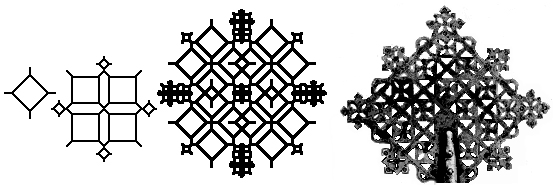Everything comes from the fractal. It’s a notion that didn’t come to me until recently, but after the heating plant visit, the group blog posts and several individual posts I have reached the conclusion that African Fractals and the ideas discussed in it is a perfect reflection of everything we have discussed in class thus far. I am fully aware of how bold and vague this statement sounds, but allow me to unpack here.
The event that put me on this train of thought was during our visit to the heating plant when myself and the other students were standing by the entrance. One of the workers started to make small talk with us and asked us what class we were part of. He was understandably confused when we told him that we were from an African American literature class. In all honesty, I think many of us were as well, I know I was. One would not usually put this class and a heating plant together, they seem foreign, distant, strange. Strange as a math textbook being assigned as part of a three-hundred level English course. Regardless, this conversation stuck with me and made me think of a line from chapter two of African Fractals, that reads as follows:
“At first glance African architecture might seem so varied that one would conclude it structures have nothing in common. Although there is great diversity among the many cultures of Africa, examples of fractal architecture can be found in every corner of the African continent.”
What better line could apply to a class where our collective blog assignment involved: a list of food we ate over spring break, a collection of nature poetry, a book about African farming methods, a chapter from Invisible Man and a visit to the heating plant. These things are outwardly disparate, and yet all of our groups managed to find thru-lines that existed between them. These books, poems, and others all tie into ideas about the deeply implicit structures that run through our everyday lives, the things deep beneath the surface that we don’t think about. They are varied, yes, but like fractals in African cultures, they constantly take different forms, different shapes.
To conclude this post, I want to bring up a line from the Snead reading, where he says, “Culture as a reservoir of inexhaustible novelty is unthinkable.” This, above all, encapsulates the spirit of our group blogging assignment. All the things we channeled were different but remarkably similar in certain ways. They were written for many varying reasons but nonetheless echoed the same ideas, providing different takes on ideas that people have been discussing for many years. Our posts, by their nature, are just another part of that cycle, part of that discussion. If this discussion could be called a “fractal”, then what we did as a class is just a small variation taking place on a greater whole. Is it prolific? Not necessarily. But we are nonetheless building on the discussion and continuing these repetitive, fractal patterns that have gone on for years. It is because of this that I believe everything comes from the fractal. This class, our discussions, our assignments, and things well outside our limited scope. They all start there and all recur in some way.
Works Cited:
- African Fractals: Modern Computing and Indigenous Design by Ron Eglash
- “On Repetition in Black Culture” by James A. Snead

